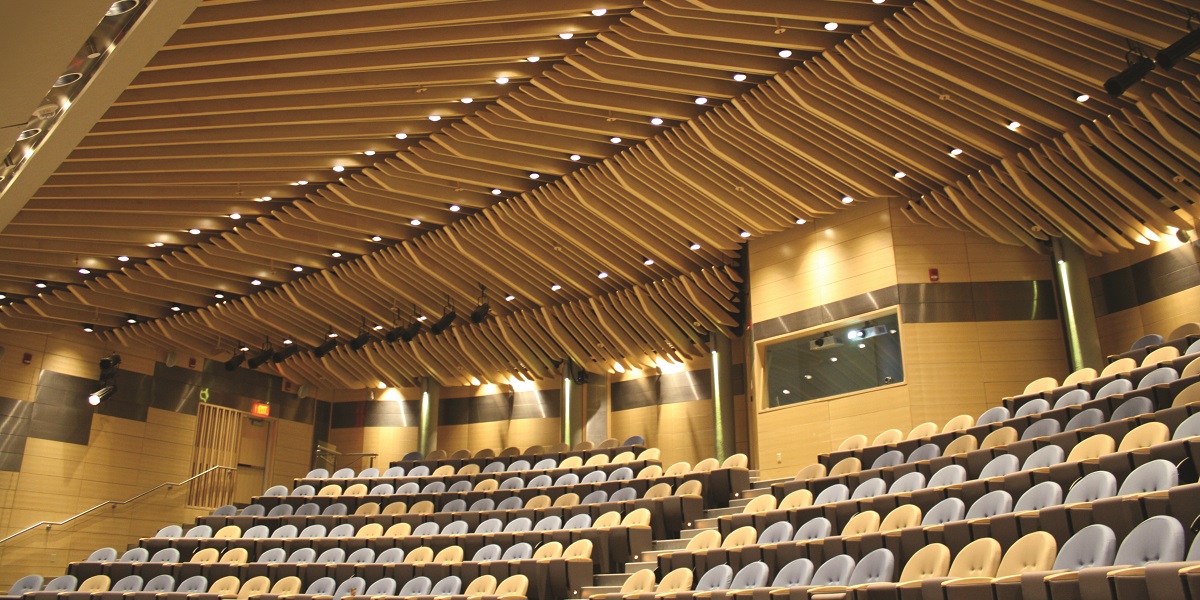Improving Acoustics in Large Rooms: A Comprehensive Guide

The Sound of Space: Why Room Acoustics Matter
Imagine attending a concert or a conference in a large hall, only to be met with poor acoustics that muddle the sound. When it comes to creating inviting and functional spaces, acoustic considerations are often overlooked. Large rooms can present unique acoustic challenges that impact comfort, communication, and overall functionality, whether it’s a conference hall, auditorium, or open-plan office.
Altispace, a premier manufacturer of acoustic solutions, offers an array of products designed to address these challenges, including Acoustic Blades, Acoustic Fins, Illuminated Acoustic Blades, and Acoustic Shapes.
Why Room Acoustics Matter
Room acoustics play a pivotal role in shaping our experience within a space. They affect how sound behaves, travels, and interacts with surfaces. In large rooms, poor acoustics can result in several issues:
Noise Disturbance: Excessive noise levels can make it difficult to hear conversations, presentations, or performances clearly, leading to frustration and reduced productivity.
Reverberation: Large rooms often suffer from long reverberation times, causing sound to linger and overlap, making speech less intelligible and music less enjoyable.
Echoes: Sound reflections off hard surfaces can create echoes, causing distractions and interfering with communication.
Sound Isolation: In open-plan offices and multi-purpose spaces, sound isolation is crucial to prevent conversations or activities in one area from disturbing others.
Understanding the Basics of Acoustics
To address acoustic challenges effectively, it’s important to grasp some fundamental concepts:
Sound Absorption: Materials with high sound absorption properties, like Altispace’s Acoustic Blades and Acoustic Fins, can reduce sound reflections and reverberation, creating a more comfortable and intelligible environment.
Reverberation Time: This is the time it takes for sound to decrease in intensity by 60 decibels after the sound source stops. Shorter reverberation times are desirable for clear communication.
Diffusion: Diffusion scatters sound reflections, reducing the intensity of direct sound and echoes. It is particularly important in large rooms with hard, reflective surfaces.
Sound Isolation: Effective sound isolation involves preventing sound from one area from leaking into another. This is crucial in spaces where privacy is important.
Benefits of Acoustically Fitted Spaces
Investing in acoustic solutions offers a multitude of advantages:
Enhanced Comfort: Improved acoustics create a more comfortable and inviting environment where people can work, learn, or relax without being disturbed by noise.
Increased Productivity: Reduced noise levels in offices lead to improved focus and concentration, resulting in higher productivity.
Improved Communication: In spaces like auditoriums and conference rooms, clear acoustics ensure that presentations and speeches are easily understood by all attendees.
Aesthetic Appeal: Acoustic solutions can be integrated seamlessly into the design of a space, enhancing its aesthetic appeal.
Large Room vs. Small Room: Which Benefits More?
While acoustic improvements benefit both large and small spaces, large rooms often face more significant challenges due to their size and the potential for greater sound reflection. In smaller rooms, sound waves are absorbed more quickly by walls, floors, and ceilings, resulting in shorter reverberation times and fewer reflections.
However, in large rooms, sound waves can travel longer distances and interact with more surfaces, leading to longer reverberation times and more pronounced acoustic issues. This is where specialized acoustic solutions, such as those provided by Altispace, can make a substantial difference.
Strategies to Improve Acoustics in Large Rooms
Now, let’s explore strategies to enhance acoustics in large rooms effectively:
Strategic Placement: Strategically install acoustic panels, such as Acoustic Blades and Acoustic Fins, on walls and ceilings to control sound reflection and reduce reverberation. These solutions are not only functional but also visually appealing.
Diffusion: Use diffusers to scatter sound reflections and create a more balanced acoustic environment. This is especially beneficial in large rooms with high ceilings.
Sound Isolation: Employ sound isolation techniques, including resilient channels, insulation, and acoustic seals, to prevent sound leakage between adjacent spaces.
Proper Seating: Choose seating arrangements that promote good acoustics, such as staggered seating in auditoriums and absorbent materials on the backs of chairs.
Ceiling Treatments: Acoustic ceilings, like Altispace’s Illuminated Acoustic Blades, offer dual functionality by improving acoustics and providing ambient lighting.
Regular Maintenance: Maintain acoustic materials and equipment to ensure they continue to perform optimally. Dust and wear can reduce their effectiveness over time.
Acoustics in large rooms should never be underestimated. Poor acoustics can lead to discomfort, reduced productivity, and hindered communication. By understanding the basics of acoustics and implementing effective strategies, large rooms can be transformed into acoustically pleasing spaces that cater to various activities and functions.
Altispace’s range of acoustic solutions provides the tools needed to create functional and aesthetically pleasing environments, ultimately enhancing the overall experience of these spaces.
Back
 Proud Member of ARCAT
Proud Member of ARCAT